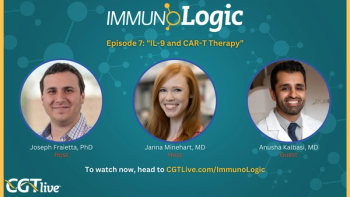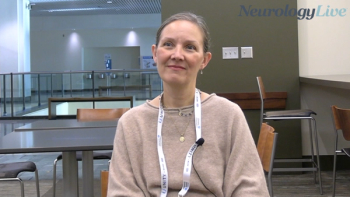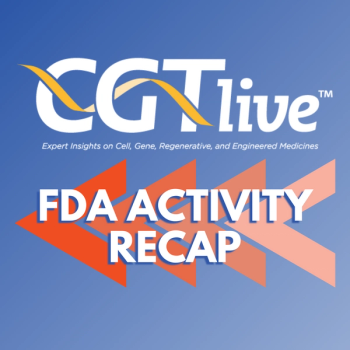
Adoption of BCMA-Directed CAR T-Cell Therapy Kickstarts A New Era in Multiple Myeloma
Nina Shah, MD, discusses the newfound role of BCMA-directed CAR T-cell therapies in multiple myeloma, how the field may select between ide-cel and cilta-cel if the latter is approved, and novel cellular therapies in clinical development.
Following the FDA approval of idecabtagene vicleucel (ide-cel; Abecma) for patients with relapsed/refractory multiple myeloma,1 experts in the field are starting to navigate a new era of myeloma treatment featuring BCMA-directed CAR T-cell products, said Nina Shah, MD.
The potential integration of ciltacabtagene autoleucel (cilta-cel), she added, as well as the development of dual-targeted CAR T-cell therapies and allogeneic products could further improve treatment for heavily pretreated patients.
“The first cellular therapy is now approved for multiple myeloma,” said Shah. “We are very excited to see how the [therapy is used in the] real world, how patients are referred, how patients are managed, and whether we can keep pushing the progression-free survival [PFS] curve upward. [The goal is that] people can start living; instead of just being patients, they can be people.”
On March 26, 2021, the FDA approved ide-cel for the treatment of patients with relapsed/refractory multiple myeloma who received 4 or more prior therapies, including an immunomodulatory agent, a proteasome inhibitor, and an anti-CD38 monoclonal antibody.
The regulatory decision was based on findings from the pivotal, phase 2 KarMMA trial, which demonstrated a 72% overall response rate (ORR) and a 28% stringent complete response (sCR) rate with ide-cel in 100 evaluable patients with heavily pretreated multiple myeloma.2
Although ide-cel was the first BCMA-directed CAR T-cell therapy approved for this patient population, another product, ciltacabtagene autoleucel (cilta-cel) is poised to enter the paradigm as well, Shah explained.
In the phase 1b/2 CARTITUDE-1 trial (NCT03548207), cilta-cel elicited a 96.9% ORR and a 67% sCR rate in 97 patients with heavily pretreated multiple myeloma.3
In April 2021, the rolling submission of a biologics license application to support the approval of cilta-cel for the treatment of patients with relapsed/refractory multiple myeloma was completed.4
In an interview with OncLive® during an Institutional Perspectives in Cancer webinar on multiple myeloma, Shah, a hematologist and oncologist, and an associate professor of medicine, Department of Medicine, at the University of California, San Francisco (UCSF) Helen Diller Family Comprehensive Cancer Center, discussed the newfound role of BCMA-directed CAR T-cell therapies in multiple myeloma, how the field may select between ide-cel and cilta-cel if the latter is approved, and novel cellular therapies in clinical development.
OncLive®: What was noteworthy about the data from the KarMMa trial with ide-cel?
Shah: Ide-cel was recently FDA approved for patients with relapsed/refractory multiple myeloma. The approval was based on the pivotal, phase 2 KarMMa study where 128 patients with relapsed/refractory multiple myeloma were infused with the BCMA-directed CAR T-cell therapy ide-cel. These patients were very sick; the median [number of] prior therapies was 6.
From those data, we learned that more than 70% of patients responded [to ide-cel], which was remarkable considering how advanced these patients’ diseases were. In the 450 million [cell]–dose, which is the dose that will be carried forward for the ide-cel product [per] the FDA label, these patients actually had greater than an 80% response rate and a median PFS of about 1 year. We haven’t seen such strong data like this for patients with [heavily] relapsed/refractory multiple myeloma previously.
Are similar toxicity challenges observed with BCMA- and CD19-directed CAR T-cell therapies? What did the safety data reveal regarding cytokine release syndrome (CRS) and neurotoxicity with ide-cel?
CRS and neurotoxicity are [toxicities] that happen with the CD19-directed CAR T-cell therapies and the BCMA-directed CAR T-cell therapies. However, [these adverse effects] seem to be a little bit different [in terms of] characteristics for myeloma [compared with other hematologic malignancies].
According to the ide-cel data, about 84% of patients had CRS, but it was mainly grade 1 and 2. The median time to onset [of CRS] was 1 day. Neurotoxicity [occurred] in around 18% of patients and was also low-grade. [Neurotoxicity] was easily treatable. It is not only that the CRS and neurotoxicity qualities are different and a little less severe with the BCMA-directed therapies, but we are also more comfortable managing [these toxicities compared with those of the CD19-directed products].
How does cilta-cel appear to compare with ide-cel in terms of efficacy?
Cilta-cel is a really exciting possible CAR T-cell therapy for patients with multiple myeloma. [Cilta-cel] is also a BCMA-directed CAR T-cell therapy that works slightly differently [than ide-cel]. The extracellular domain that binds to BCMA, binds to 2 epitopes of BCMA instead of 1, the latter of which is the case with ide-cel.
The data from the CARTITUDE-1 study have been unprecedented. All patients were heavily pretreated; the median number of prior therapies was 6, which was very similar to the ide-cel group.
In this dataset, 97% of patients responded and 94% had a very good partial response or better [with cilta-cel]. Also, [we saw] very deep responses [with cilta-cel]. The minimal residual disease data look very good as well.
We do not have the long-term follow-up data, but it seemed as though more than half of patients were still in remission as of the 12-month cut-off. Of course, these are not mature data, so we don’t know exactly [how durable these responses are]. Preliminarily, [the data with cilta-cel] appear to be even better than the data we’ve seen with ide-cel.
Did the safety data from the CARTITUDE-1 trial reveal anything unique about CRS and neurotoxicity with cilta-cel?
Almost all patients [developed] CRS [with cilta-cel], but again, these were mainly grade 1 or 2 toxicities and were very treatable. A good portion of patients had some sort of neurotoxicity. However, what was interesting is that not all of the [neurotoxicities observed] are what we consider immune effector cell–associated neurotoxicity syndrome. [Patients had] some cognitive [toxicity] and other types of motor neuropathy. These were a little bit mysterious but were too [infrequent] to really understand a pattern. This is something that [providers] will have to look out for when [cilta-cel] is brought to a wider variety of patients.
Something interesting about the CRS was that the median time to onset was 7 days, with a range of 1 to 14 days. That means that [the CRS with cilta-cel] is a little less predictable, but that maybe not all patients need to be in the hospital for all 14 days [following infusion with cilta-cel]. The same is also true for ide-cel.
How do you anticipate the field will select between ide-cel and cilta-cel if cilta-cel receives an approval?
If the PFS [with cilta-cel] blows [the data seen with ide-cel] out of the water, a lot of people are going to be excited to use [cilta-cel]. There will be some pause to make sure that the neurotoxicity is well recognized and work to see ultimately what predicts for [neurotoxicity] so that we may prevent it. Again, [neurotoxicity] didn’t happen all that often, but for the select few patients in which it did happen, it was significant.
Otherwise, we are very excited to have not 1 but maybe 2 CAR T-cell therapy options out there for our patients with multiple myeloma. More options are always better when it comes to patient care.
What is next for cellular therapies in relapsed/refractory multiple myeloma?
Although we have done a good job of treating [patients with] multiple myeloma with BCMA-directed CAR T-cell therapies, we haven’t cured multiple myeloma and there is not a plateau on that [survival] curve. Therefore, we are always looking for new ways to treat [patients], particularly when we consider the CAR T-cell therapy field. There are some changes and advances going on.
One is that other targets are being explored, including GPRC5D. There are also dual-targeting CAR T-cell therapies [under investigation], such as [therapies targeting] CD38 and BCMA or CD19 and BCMA.
Also, there are different ways to culture the CAR T cells to bring out the memory population and improve persistence and potentially duration of response.
Something else that is going to be a different kind of splash from a different direction is the allogeneic CAR T-cell therapies, which will allow patients to avoid the step of apheresis and go straight to getting CAR T cells. That is something that is going to have a niche in the market because it is hard to do all the logistics [that are required of current autologous products]; that is sometimes what prevents people from getting this type of therapy. If [allogeneic CAR T-cell therapies] are pretty effective and tolerable as far as toxicity goes, they will be another option for patients.
References
- FDA approves idecabtagene vicleucel for multiple myeloma. FDA. News release. March 26, 2021. Accessed May 5, 2021.
https://bit.ly/3eTY9JD - Munshi NC, Anderson LD Jr, Shah N, et al. Idecabtagene vicleucel (ide-cel; bb2121), a BCMA-targeted CAR T-cell therapy, in patients with relapsed and refractory multiple myeloma (RRMM): initial KarMMa results. J Clin Oncol. 2020;38(suppl 15):8503. doi:10.1200/JCO.2020.38.15_suppl.8503
- Madduri D, Berdeja JG, Usmani SZ, et al. CARTITUDE-1: phase 1b/2 study of ciltacabtagene autoleucel, a B-cell maturation antigen-directed chimeric antigen receptor t cell therapy, in relapsed/refractory multiple myeloma. Presented at: 47th Annual Meeting of the European Society for Blood and Marrow Transplantation; March 14-17, 2021; virtual. Accessed May 5, 2021.
- Form 20-F Legend Biotech Corp: Annual and transition report of foreign private issuers [sections 13 or 15(d)]. Accessed April 6, 2021. https://bit.ly/3fLKJ4h.
Newsletter
Stay at the forefront of cutting-edge science with CGT—your direct line to expert insights, breakthrough data, and real-time coverage of the latest advancements in cell and gene therapy.











































